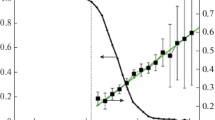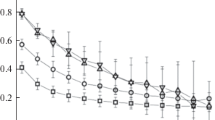Abstract
The production of metal nanopowders with specified sizes requires an analysis of the relationship between the physical conditions in industrial installations and the geometric properties of nanoparticles. Predictive mathematical modeling is one of the possibilities of investigating this relationship. The use of thermodynamic nucleation models does not allow one to achieve quantitative agreement with experiment results, so the data can differ by a few orders of magnitude. The kinetic Monte Carlo methods popular in recent decades make it possible to approach the scale of a real experiment; however, they consider an initial state of a medium as ideal crystalline nuclei formed in advance and evenly distributed in space, on the surface of which adsorption and desorption processes take place, and monomers diffuse to their surface in the medium. The rates of these processes are determined by coefficients, the values of which can be chosen to best describe experimental data or calculated using MD simulation. These methods do not consider the stage of nucleation and a detailed description of nucleation; therefore, it is impossible to take into account, e.g., the appearance of stable isomeric forms, “magic” clusters, and so on. In this work, we perform a multiscale simulation of the nucleation of copper nanoparticles in a gas-phase condensation chamber. The data used for a mathematical description of the atomic level of nucleation are obtained by analyzing the results of molecular dynamics calculations of copper vapor condensation at various degrees of supersaturation. The microdescription results are used in a macroscopic model, which includes a system of equations of motion, heat conduction, and diffusion. The analysis includes a description of nucleation, unimolecular growth, and coagulation. The concentrations of clusters of various sizes are taken into account on a logarithmic scale. In areas with a temperature close to the boiling point of copper, cluster grow is found to occur mainly via the attachment of monomers; in low-temperature areas, coagulation is the predominant growth mechanism.




Similar content being viewed by others
REFERENCES
A. I. Gusev and A. A. Rempel’, Nanocrystalline Materials (FIZMATLIT, Moscow, 2001).
K. Gonsalves, K. Halberstadt, K. Lorensin, and L. Nair, Nanostructures in Biomedicine (Binom, Moscow, 2020).
L. I. Boguslavskii, “Methods of synthesis of nanoparticles and their size-sensitive physical parameters,” Tonkie Khim. Tekhnol. 5, 3–12 (2010).
A. G. Vorontsov, A. E. Korenchenko, and B. R. Gelchinski, High Temp. 57, 368–371 (2019). https://doi.org/10.1134/S0018151X19030180
A. E. Korenchenko, A. G. Vorontsov, B. R. Gel’chinskii, and G. P. Sannikov, Physica A 496, 147–155 (2018). https://doi.org/10.1016/j.physa.2017.12.083
A. E. Korenchenko, A. G. Vorontsov, B. R. Gel’chinskii, and A. A. Zhukova, High Temperature 57, 275–278 (2019). https://doi.org/10.1134/S0018151X1902007X
A. E. Korenchenko, A. G. Vorontsov, and A. A. Zhukova, Russ. Metall. 2020, 150–154 (2020). https://doi.org/10.1134/S0036029520020093
A. E. Korenchenko, B. R. Gel’chinskii, and A. G. Vorontsov, Russ. Metall. 2020, 877–884 (2020). https://doi.org/10.1134/S003602952008008X
A. E. Korenchenko, B. R. Gelchinski, and A. G. Vorontsov, J. Phys. Condens. Matter. 32 (30), 304002 (2020). https://doi.org/10.1088/1361-648x/ab7fd9
O. K. Rice and H. C. Ramsperger, J. Am. Chem. Soc. 50 (3), 617–620 (1928). https://doi.org/10.1021/ja01390a002
V. Weisskopf, Phys. Rev. 52, 295–303 (1937). https://doi.org/10.1103/PhysRev.52.295
S. P. Fisenko, “Microstructure of the supersaturation field during homogeneous nucleation in a vapor–gas mixture,” ZhTF 83 (5), 35–40 (2013).
M. P. Anisimov, Russ. Chem. Rev. 72 (7), 591–628 (2003). https://doi.org/10.1070/RC2003v072n07ABEH000761
V. I. Kalikmanov, Nucleation Theory (Springer, 2013).
R. Bird, W. Stewart, and E. Lightfoot, Transport Phenomena (Wiley, New York, 2002).
A. N. Matveev, Molecular Physics (Lan’, Moscow, 2010).
O. Yu. Subbotina, “Mechanism and kinetics of formation of ultrafine powders during the intense evaporation of the copper–tin system into an inert gas atmosphere,” Candidate’s Dissertation in Chemistry (Yekaterinburg, 2001).
Funding
This work was carried out according to a state assignment to the Institute of Metallurgy, Ural Branch, Russian Academy of Sciences and was supported in part by the Russian Foundation for Basic Research (project no. 20-03-00370). The calculations were made on the URAN supercomputer of the Institute of Mathematics and Mechanics, Ural Branch, Russian Academy of Sciences.
Author information
Authors and Affiliations
Corresponding author
Ethics declarations
The authors declare that they have no conflicts of interest.
Additional information
Translated by K. Shakhlevich
Rights and permissions
About this article
Cite this article
Korenchenko, A.E., Vorontsov, A.G., Okulov, R.A. et al. Simulation of the Self-Assembly of Metal Nanoclusters. Russ. Metall. 2022, 927–932 (2022). https://doi.org/10.1134/S0036029522080067
Received:
Revised:
Accepted:
Published:
Issue Date:
DOI: https://doi.org/10.1134/S0036029522080067




